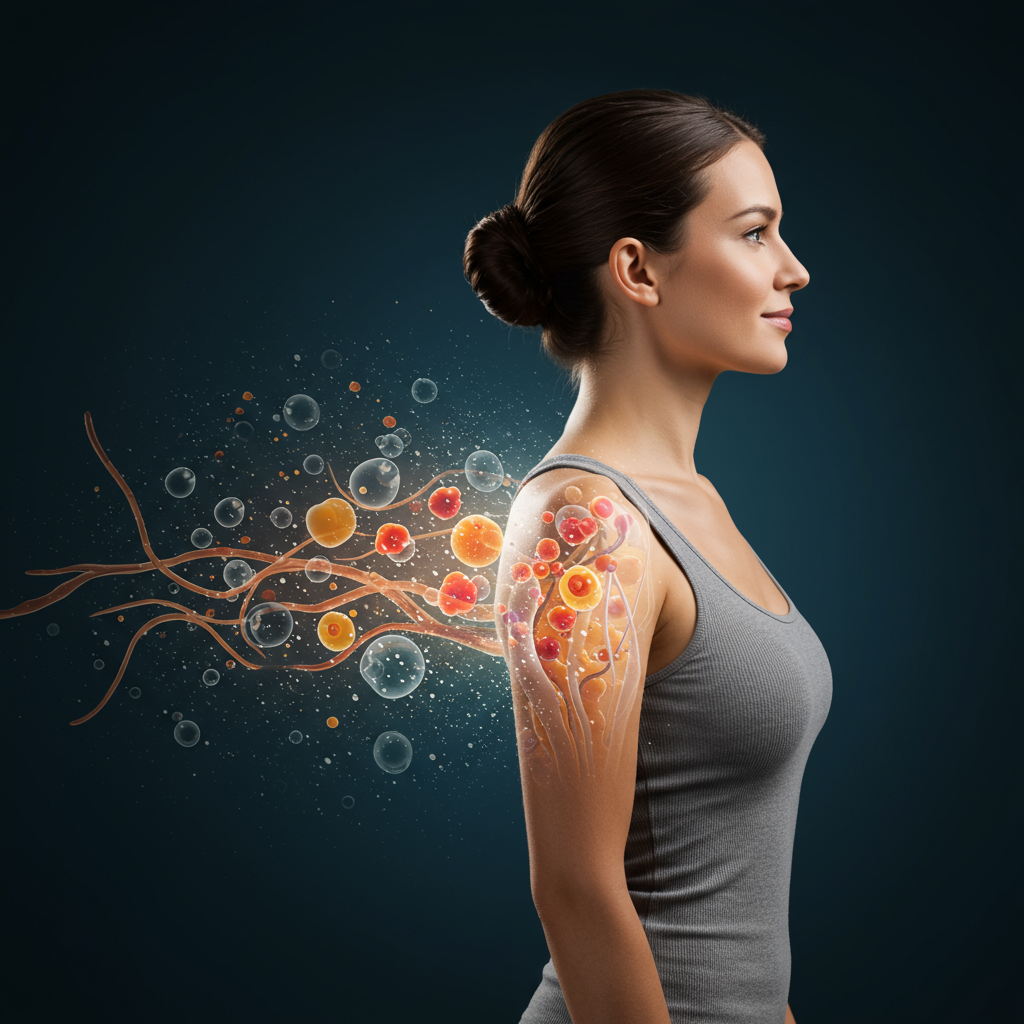Beyond their crucial role in reproduction, ovaries are now recognized as central drivers of women’s overall health and how they age. These small organs have a profound impact on well-being throughout a woman’s entire life. Understanding ovarian health is key to improving healthspan, the years lived in good health, especially as women live longer than ever before. Research reveals that ovarian aging happens surprisingly fast compared to other organs. This decline doesn’t just end fertility; it affects numerous bodily systems, increasing risks for many age-related conditions.
This article explores the ovary’s far-reaching influence on health. We look at how ovaries function, what happens as they age, and their link to common diseases. We also examine current research and potential future strategies to support ovarian health for a healthier, longer life.
The Ovary: More Than Just Reproduction
At birth, a female ovary contains millions of tiny sacs called follicles. Each follicle holds an immature egg and support cells. This finite supply of follicles is all a woman will ever have. By puberty, the number significantly decreases. The journey from an initial follicle to a mature egg ready for ovulation is long and complex. About a thousand follicles are recruited each month, but typically only one fully matures. The vast majority are naturally eliminated by the ovary.
While ovulation is part of the monthly cycle, the ovary’s function is continuous and dynamic. This ongoing process involves remarkable cellular changes within the follicles. They transform in structure, function, and the types of hormones they produce over time.
A Symphony of Hormones
The ovary is primarily known for producing eggs. However, its role as an endocrine organ producing hormones is equally vital. Follicles that don’t ovulate still contain support cells. These cells produce many hormones, not just estrogen and progesterone. These hormones regulate the menstrual cycle. More importantly, they act as signaling molecules throughout the body.
Traveling through the bloodstream, ovarian hormones reach organs with specific receptors. The brain, bones, blood vessels, breasts, and metabolic tissues all respond to these signals. This hormonal communication is like a complex symphony. It orchestrates various bodily functions, including bone health, heart health, metabolism, and cognitive function. As ovarian function declines with age, hormone production changes. This disruption can turn the body’s harmonious symphony into a discordant noise, impacting overall health.
How Ovarian Aging Impacts Healthspan
Women generally live longer than men. However, they often spend more years dealing with chronic diseases or disabilities. This gap between lifespan and healthspan is strongly linked to menopause. Menopause is the natural end of menstrual cycles, typically occurring around age 50. It marks a significant decline in ovarian hormone production.
Research clearly shows health outcomes worsening after menopause. Before age 55, women have a lower risk of cardiovascular disease than men their age. After 55, this risk increases sharply, often exceeding that of men. Studies indicate that experiencing menopause earlier is associated with a higher risk of death from heart events. Conversely, later menopause is linked to living to age 90.
Increased Risk of Chronic Conditions
Ovarian aging’s impact extends beyond life-threatening diseases. Women often face more chronic, non-fatal conditions after age 45 compared to men. As ovaries decline, the risk for several conditions increases:
Osteoporosis: Estrogen is critical for bone building. The drop in estrogen during menopause causes significant bone density loss. Women can lose 10-20% of density in the first five years post-menopause. This increases fracture risk, with 1 in 2 women over 50 breaking a bone.
Cardiovascular Disease: Estrogen helps keep blood vessels flexible. It promotes new vessel growth and reduces inflammation. These effects contribute to lower blood pressure and better heart function during reproductive years. With lower estrogen after menopause, this protection is lost.
Cognitive Decline: Estrogen influences many brain areas. Longer exposure to estrogen during reproductive years may protect brain health. Studies show earlier menopause is linked to an increased risk of dementia.
Metabolic Changes: Estrogen helps regulate blood sugar. It supports insulin production and sensitivity. It also influences fat storage and metabolism. The loss of estrogen often leads to increased abdominal weight gain. This raises the risk of type 2 diabetes, heart disease, and certain cancers.
Autoimmune and Joint Health: Postmenopausal women, particularly those with early menopause, face a higher risk of conditions like rheumatoid arthritis. Longer reproductive windows may offer protection against progressive multiple sclerosis.
Experts suggest that delaying ovarian aging could prevent this cascade of health problems. It could allow women to live healthier lives for longer.
Understanding the Mechanisms of Ovarian Decline
The number of follicles decreases steadily throughout a woman’s life. Only about 12% of the original egg cells remain by age 30. By age 40, this number can drop to a mere 3%. The rate of loss accelerates later, although the exact reasons are not fully understood.
Follicle quality also diminishes with age. Older follicles are more likely to have genetic defects. Eggs released might have chromosome abnormalities. This makes conception more difficult and increases miscarriage risk.
Cellular Wear and Tear
Ovaries undergo immense cellular turnover. Thousands of follicles die each month for one to potentially mature. This constant degradation requires significant cleanup. This differs from other organs that experience more gradual aging.
Ovulation itself contributes to aging. Each month, a follicle ruptures to release an egg. This leaves a temporary wound on the ovary surface. The ovary must then heal this micro-injury. This process repeats hundreds of times over a lifetime. Over time, these repeated injuries can degrade the ovary’s structure. This affects its function and leads to increased stiffness. The ovary becomes more rigid, moving from a soft, spongy texture to a tougher, less flexible one. This stiffness can negatively impact follicle development and hormone production.
The Role of Mitochondria and Epigenetics
At a cellular level, ovarian aging involves fundamental biological processes. Mitochondrial dysfunction is a key hallmark. Mitochondria are the powerhouses of cells. In ovaries, they are crucial for energy production needed for follicle and egg development. They also regulate apoptosis (cell death) and steroid hormone synthesis. As ovaries age, mitochondrial function declines. This includes reduced energy production and increased production of reactive oxygen species (ROS), causing oxidative damage.
Epigenetic changes are also critical contributors. These are modifications to DNA or its associated proteins that alter gene expression. They happen without changing the underlying DNA sequence. These changes occur in both nuclear and mitochondrial DNA. They affect genes vital for ovarian function, fertility, and DNA repair. Environmental factors like endocrine disruptors, stress, and nutrition can cause harmful epigenetic changes. Mitochondrial metabolites like acetyl-CoA and NAD+ are essential cofactors for enzymes that control these epigenetic marks. This highlights a deep connection between metabolism and ovarian aging.
Tracking and Influencing Ovarian Health
Unlike many other organs, assessing overall ovarian aging isn’t straightforward. There’s no single routine test to track its trajectory over time.
The most familiar indicator is the menstrual cycle. Regular periods signal predictable hormone production. Irregular or missed periods can be early signs of ovarian decline. For many, perimenopause begins with gradual, erratic changes in cycles. This phase can last up to a decade before menstruation stops. It is associated with numerous symptoms (up to 135 different ones). These include hot flashes, sleep disturbances, vaginal dryness, mood changes, and brain fog.
Menstrual Cycle as a Vital Sign?
Some experts propose the menstrual cycle as a vital sign for women’s health. It offers insights into ovarian function and hormonal balance. However, hormonal birth control masks natural cycle changes. Conditions like PCOS already cause irregular periods. Current tests like Anti-Müllerian hormone (AMH) levels and Antral Follicle Count (AFC) provide only a snapshot. They show the current state of the egg reserve but not the future trajectory of ovarian health.
Early Life Factors and Lifestyle
Emerging research shows that ovarian health is influenced from very early life. Events in utero, such as low birth weight or exposure to certain chemicals, can increase the risk of earlier menopause. Nutritional status and environmental exposures from gestation through childhood and adolescence are crucial. Factors like the age of menarche (first period) are also linked to future health risks. Early or late menarche may increase the risk of cardiovascular disease and type 2 diabetes later in life. Attention to diet and environment during these formative years is vital for protecting ovarian health and later healthspan.
While lifestyle cannot stop ovarian aging entirely, it is incredibly important. Regular exercise, especially strength training, supports bone and muscle health. A healthy diet counteracts metabolic changes linked to hormone decline. Managing stress and getting enough sleep also ease the transition and lower long-term risks. These lifestyle changes are key tools for managing the effects of ovarian aging.
The Future of Ovarian Aging Research
Reproductive aging is significantly under-researched and underfunded. This lack of focus hinders progress in developing interventions. However, research is picking up pace, exploring promising avenues.
Potential Interventions on the Horizon
Pharmaceuticals: Researchers are testing compounds that target specific aspects of ovarian aging. One approach involves mimicking AMH to regulate follicle development. Another explores repurposing drugs studied for general aging. Rapamycin, an FDA-approved drug known to affect the mTOR pathway, is being investigated. Early results from a clinical trial (VIBRANT study) suggest low-dose rapamycin might slow ovarian aging by approximately 20%. This could potentially delay menopause by about five years.
Targeting Stiffness: Research is focused on ovarian stiffness. Scientists are developing non-invasive imaging techniques like ultrasound elastography to measure stiffness. Medications that reduce fibrosis (scarring) in the ovary are also being studied. Reducing stiffness could help preserve hormone production and function.
Cryopreservation: Freezing and later reimplanting a small piece of ovarian tissue is used to preserve fertility. Mathematical models suggest this procedure could also significantly delay menopause by effectively replenishing the ovarian reserve. This method currently requires surgery.
- Personalized Approaches: The future may involve tailored interventions. Instead of one-size-fits-all hormone therapy, women could receive combinations of compounds. These could target specific tissues like bone or brain without affecting others like breast tissue. Diagnostic panels could help determine the most effective approach for individuals.
- www.usatoday.com
- www.openaccessgovernment.org
- www.frontiersin.org
- www.forbes.com
- www.vox.com
The goal of these interventions isn’t solely to extend fertility. It’s primarily to extend the period of healthy endocrine function (healthspan). This aligns a woman’s biological state with her increasing chronological lifespan.
Challenges and the Need for Funding
Significant research is still needed. We need a deeper understanding of the long-term risks versus benefits of delaying ovarian aging. Later menopause is linked to a higher risk of certain cancers (breast, ovarian, endometrial). This may be due to longer estrogen exposure. However, experts believe the healthspan benefits would likely outweigh these risks.
A major challenge is funding. Despite affecting half the population and linking to significant health issues, ovarian aging research receives limited support. Initiatives like decentralized science funding are emerging to help bridge this gap. Increased political attention and investment are also starting to address this historical disparity.
Researchers and clinicians currently have limited answers for women asking how to slow ovarian aging. More fundamental research is necessary. This includes understanding complex cellular processes like the interplay between mitochondria and epigenetics. Developing comprehensive diagnostic tools that track ovarian health over time is also critical.
By shifting the focus from solely reproductive function to the ovary’s systemic role, we can unlock new potential. Investing in ovarian aging research promises significant opportunities. It can improve women’s health, extend their healthspan, and transform how we approach aging for half of humanity.
Frequently Asked Questions
What specifically happens to ovaries as women age, and what are the main health consequences?
As women age, the number and quality of follicles within the ovaries decline significantly. The process of ovulation also causes cumulative micro-injuries, leading to increased ovarian stiffness and fibrosis. At a cellular level, mitochondria become dysfunctional, and epigenetic patterns change, disrupting gene expression vital for ovarian function. This progressive decline results in reduced hormone production, primarily estrogen. The main health consequences include increased risks for cardiovascular disease, osteoporosis, cognitive decline like dementia, metabolic changes leading to diabetes and weight gain, and certain autoimmune conditions after menopause.
How can women currently assess or track their ovarian health?
The most accessible indicator is the menstrual cycle’s regularity. Consistent cycles suggest predictable hormone production, while irregular periods can signal early decline. Some experts propose viewing the menstrual cycle as a vital sign. Clinical tests like Anti-Müllerian hormone (AMH) levels and Antral Follicle Count (AFC) provide a snapshot of current ovarian reserve, but they don’t predict future health trajectory. Factors like hormonal birth control can mask natural cycle changes, making tracking more complex. Better diagnostic tools are needed.
Can lifestyle changes or medical interventions delay ovarian aging or its effects?
While lifestyle changes cannot stop ovarian aging, they can significantly manage its effects and lower long-term health risks. Regular exercise (especially strength training), a healthy diet, stress management, and sufficient sleep are crucial. Hormone therapy can manage menopausal symptoms and may offer health benefits if started early, though risks need assessment. Promising research areas for potentially delaying ovarian aging itself include pharmaceutical interventions targeting follicle regulation, repurposing drugs like Rapamycin (showing early promise), and therapies aimed at reducing ovarian stiffness. However, these are still largely in early research or clinical trial phases.




